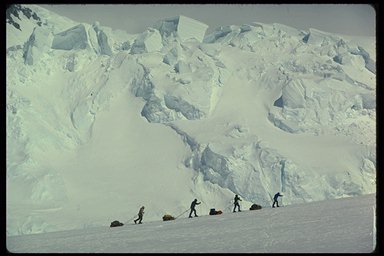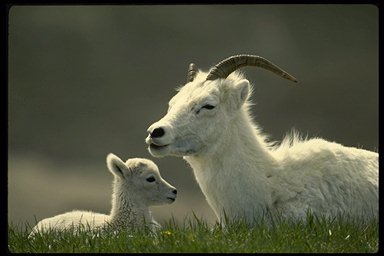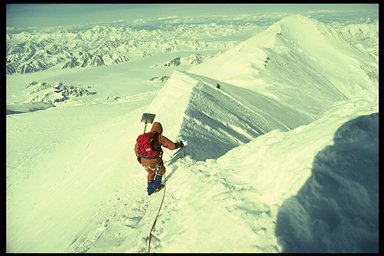
The highest mountains in Canada, the largest non-polar icefields, the fastest, longest glaciers. This is a land in flux, a young land, a land still in the throes of creation. Volcanoes have been at work here making mountains; glaciers and rivers are carrying them away. Flowing in slow-motion, glaciers move vast amounts of pulverized rock down the valleys, sculpting the landscape. Glaciers spawn rivers opaque with silt, rivers moving mountains.

Mountains and glaciers - these are the essence of this region. Mount Logan, Canada's highest point at 5951 metres, towers over the massive St. Elias range. The Boundary Ranges, running north-south along the Alaska panhandle, the second major mountain system making up this region, are no less spectacular. These two mountain ranges spawn thousands of glaciers. They spill down the valleys from massive icefields. Over 2000 glaciers are found in Kluane National Park Reserve alone. These are classic valley glaciers - some over 100 kilometres long - sinuously striped in black and white by gravel moraines.

The effects of the most recent Ice Age have not been dulled by erosion or hidden by vegetation. It is as if the ice sheets retreated yesterday. Broad U-shaped valleys, hanging valleys, cirques and other glacial landforms are evidence of their passing.
This region has some of Canada's most spectacular rivers. The Tatshenshini, the Alsek, the lower reaches of the Stikine - these and other wild, unfettered rivers provide breath-taking scenery and thrills for wilderness adventurers.
VEGETATION:
The vegetation of this region is a composite of species from the coast, the western mountains, the boreal forest, the Arctic and the northern prairies, tentatively poking up the valleys toward the glaciers and icefields. The coast forest of stately western hemlock and sitka spruce intrudes from the west; the boreal forest of sharp-pointed spruce marches up the glacier-carved valleys from the east. Alpine tundra and meadows, a complex mosaic of grasses, herbs, shrubs and dwarf trees adapted to a brief growing season and frequent snow throughout the year, prevail at higher elevations. In September, aspen brighten the mountain flanks with sheets of brilliant yellow.
WILDLIFE:
This region is home to some of the continent's most spectacular wildlife, wildlife in scale to the size of the mountains. The largest sub-species of moose in the world is found here, with bulls weighing in at over 800 kilograms. The grizzly bears are almost as big as the moose. Dall's sheep, woodland caribou, mountain goats and other large mammals abound.

STATUS OF NATIONAL PARKS:
Kluane National Park and National Park Reserve (22 013 km2) includes many of the natural features, wildlife and vegetation that typify this region. A wilderness area famous for its abundant grizzly bears, Dall's sheep, caribou and mountain goats, it also includes the highest mountain in Canada (Mount Logan), vast ice fields and surging glaciers. Fringing the glaciers and mountains is a narrow "green belt" ranging from coniferous and deciduous forests to alpine tundra, covering about 18 percent of the park and providing important habitat for the park reserve's abundant wildlife.
In 1993, Canada, the Champagne and Aishihik First Nations and Yukon Government concluded a comprehensive land claim agreement. This resulted in the eastern portion of the park reserve lying in the claim area (about 30%) changing from reserve, to full national park status. Pending settlement of the Kluane First Nation and White River First Nation land claims, the remaining western portion remains a park reserve.
